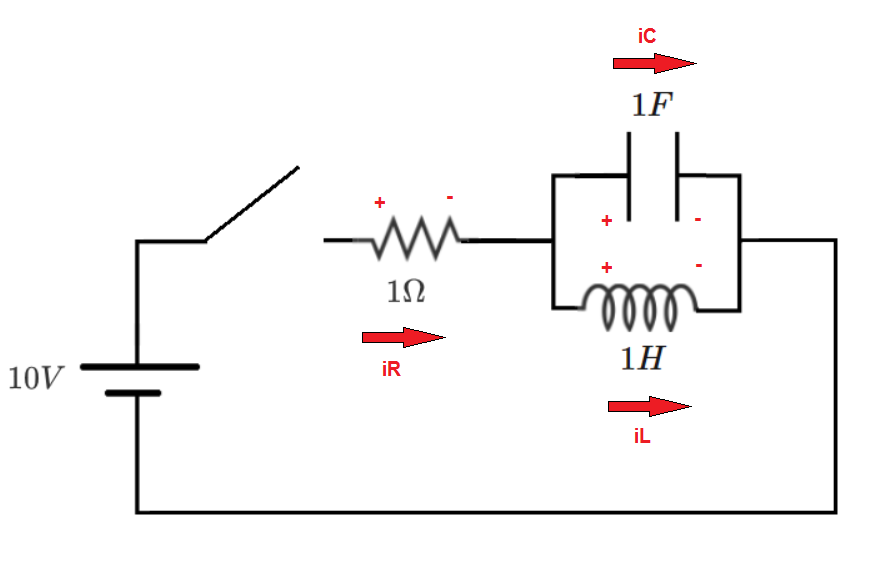RLC Switching - Quantitative
In the circuit below (with DC source), the switch closes at t = 0 . Prior to closing, the inductor and capacitor are completely de-energized. What is the value of the ratio Minimum resistor current for t ≥ 0 Maximum resistor current for t ≥ 0 ?
The answer is 2.4.
This section requires Javascript.
You are seeing this because something didn't load right. We suggest you, (a) try
refreshing the page, (b) enabling javascript if it is disabled on your browser and,
finally, (c)
loading the
non-javascript version of this page
. We're sorry about the hassle.
2 solutions
Well done!

The system state variables are the capacitor voltage and the inductor current. Write expressions for the time-derivatives of the state variables in terms of the state variables and the forcing function (the DC source voltage). Note the voltage and current polarity conventions in the diagram.
Capacitor:
i C = C d t d v C i R − i L = C d t d v C R v S − v C − i L = C d t d v C d t d v C = C R v S − v C − i L
Inductor:
v L = L d t d i L v C = L d t d i L d t d i L = L v C
Numerical integration yields a minimum resistor current value of 4.537, and a maximum value of 10.891, with the ratio of the two being approximately 2.4. The current reaches a constant value of 10 amps in steady-state, as expected.
We can use Laplace transform to solve this. After taking the transform to the circuit, we get:
Then we have I R ( s ) = R + X C + X L X C X L V ( s ) = s ( s 2 + s + 1 ) 1 0 ( s 2 + 1 ) .
We propose the following partial fraction descomposition: I R ( s ) = s A + s − z 1 z + s − z 2 z , where z 1 , 2 = − 2 1 ± 2 3 i are the roots of s 2 + s + 1 = 0 .
Hence we have: A = I R ( s ) ( s − 0 ) ∣ s = 0 = 1 0 and z = I R ( s ) ( s − z 1 ) ∣ s = z 1 = 3 1 0 i .
Take inverse Laplace transform: i R ( t ) = A + z e z 1 t + z e z 2 t = 1 0 + 3 1 0 i e ( − 2 1 + 2 3 i ) t − 3 1 0 i e ( − 2 1 − 2 3 i ) t = 1 0 − 3 2 0 e − 2 t sin ( 2 3 t ) .
Now, i R ′ ( t ) = − 3 2 0 e − 2 t ( − 2 1 sin ( 2 3 t ) + 2 3 cos ( 2 3 t ) ) . The minimum value will occur at the first positive solution of i R ′ ( t ) = 0 and the maximum value at the second.
So, i R ′ ( t ) = 0 ⟹ 2 1 sin ( 2 3 t ) = 2 3 cos ( 2 3 t ) ⟹ tan ( 2 3 t ) = 3 ⟹ t = 3 2 ( 3 π + π k ) .
Finally: